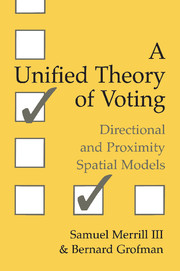Book contents
- Frontmatter
- Contents
- List of Tables and Figures
- Acknowledgments
- 1 Introduction
- Part I Models of Voter Behavior
- 2 Alternative Models of Issue Voting
- 3 A Unified Model of Issue Voting: Proximity, Direction, and Intensity
- 4 Comparing the Empirical Fit of the Directional and Proximity Models for Voter Utility Functions
- 5 Empirical Model Fitting Using the Unified Model: Voter Utility
- 6 Empirical Fitting of Probabilistic Models of Voter Choice in Two-Party Electorates
- 7 Empirical Fitting of Probabilistic Models of Voter Choice in Multiparty Electorates
- Part II Models of Party or Candidate Behavior and Strategy
- Postscript
- Appendices
- Glossary of Symbols
- References
- Index
6 - Empirical Fitting of Probabilistic Models of Voter Choice in Two-Party Electorates
Published online by Cambridge University Press: 04 December 2009
- Frontmatter
- Contents
- List of Tables and Figures
- Acknowledgments
- 1 Introduction
- Part I Models of Voter Behavior
- 2 Alternative Models of Issue Voting
- 3 A Unified Model of Issue Voting: Proximity, Direction, and Intensity
- 4 Comparing the Empirical Fit of the Directional and Proximity Models for Voter Utility Functions
- 5 Empirical Model Fitting Using the Unified Model: Voter Utility
- 6 Empirical Fitting of Probabilistic Models of Voter Choice in Two-Party Electorates
- 7 Empirical Fitting of Probabilistic Models of Voter Choice in Multiparty Electorates
- Part II Models of Party or Candidate Behavior and Strategy
- Postscript
- Appendices
- Glossary of Symbols
- References
- Index
Summary
[We add] to our theory that behavior is a resultant of psychological forces our conception of identification with party …
Angus Campbell et al., The American Voter (1960: 9)Probabilistic Models
The models considered previously have all been deterministic and issue based, i.e., each voter was assumed certain to select that candidate whose issue-oriented utility was highest. Yet voters use criteria other than issues to choose candidates. The probability, furthermore, that even an issue-oriented voter will select the candidate of higher utility is certainly less than unity if utilities do not differ greatly. Hinich and Munger state (1994: 167):
As researchers, we might reasonably divide the set of determinants for a given individual's vote into those that we, the researchers, can identify and measure in some consistent fashion and those that are idiosyncratic (hence, for us, unpredictable) and specific to each voter.
From the perspective of a candidate or party, such idiosyncratic factors for any given voter are unknown (i.e., are unpredictable) but their probability distributions can be known. Accordingly, they may be modeled as random variables.
From a methodological perspective, as the number of candidates or parties increases, it is easier to rely on voter choice to distinguish between models so that we no longer have to depend on the shapes of voter utility functions. Arbitrary assignment of voters to the single candidate (party) of highest utility, however, becomes increasingly misleading. More realistically, in light of unmeasured variables, voters should be assigned to parties on a probabilistic basis.
- Type
- Chapter
- Information
- A Unified Theory of VotingDirectional and Proximity Spatial Models, pp. 81 - 90Publisher: Cambridge University PressPrint publication year: 1999



